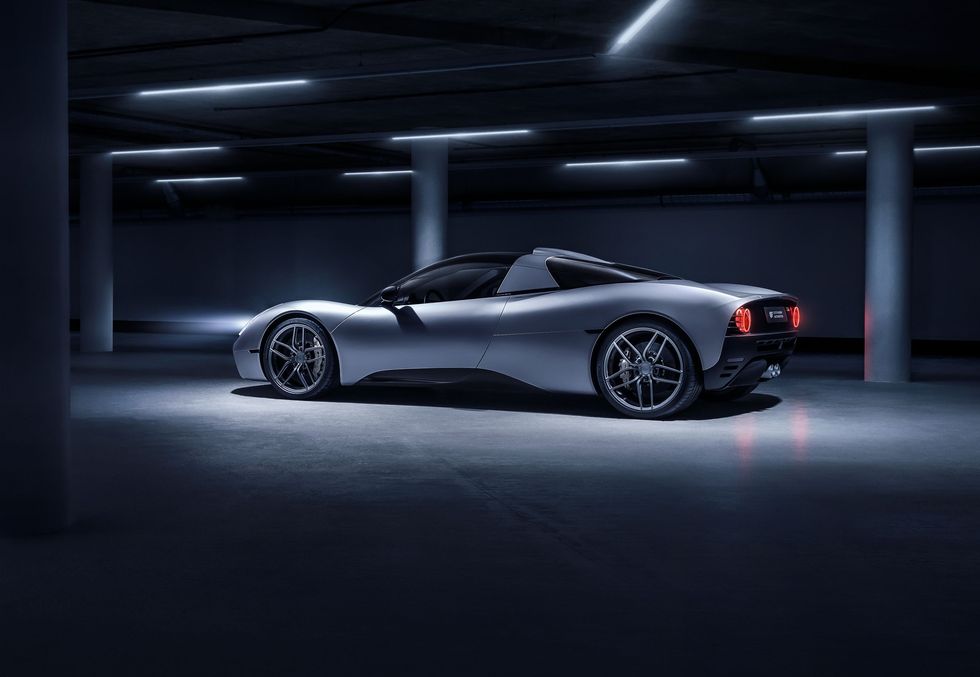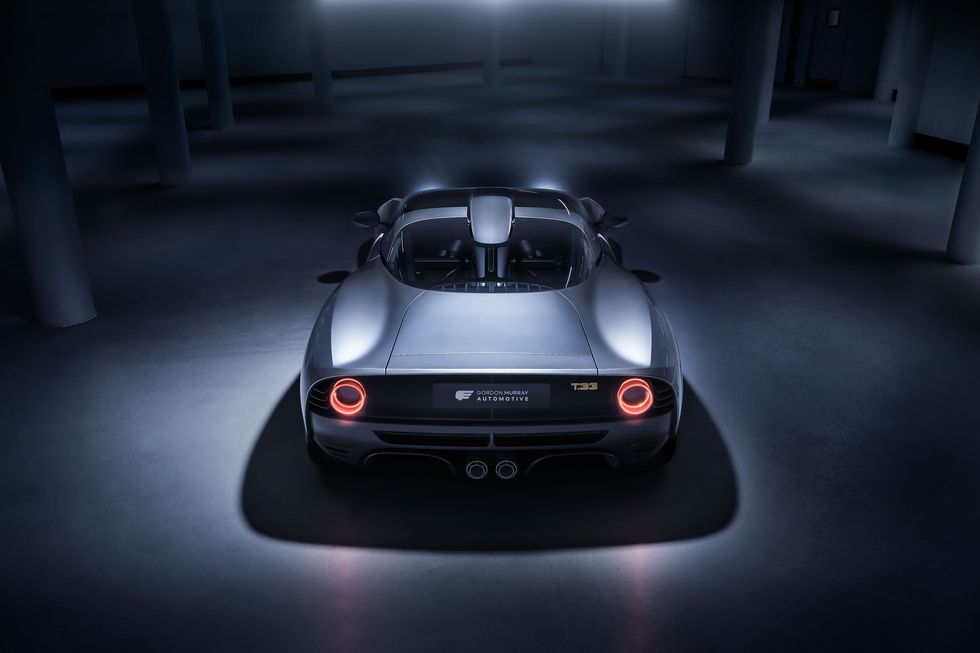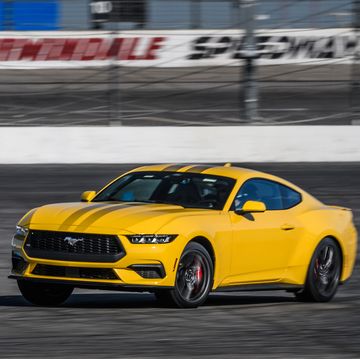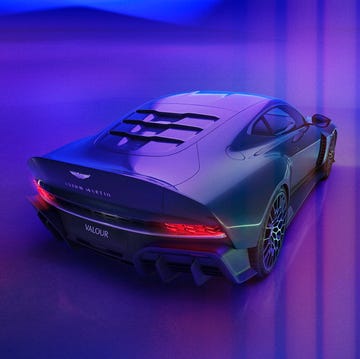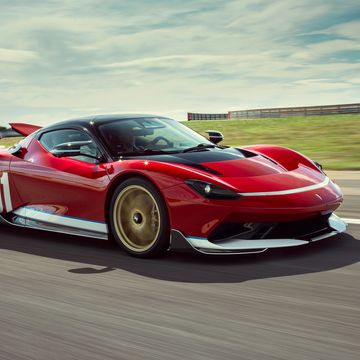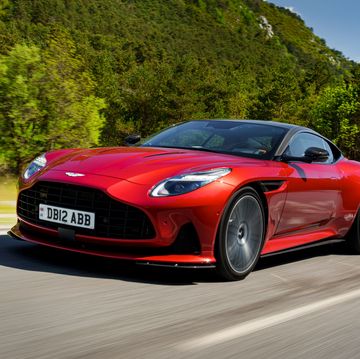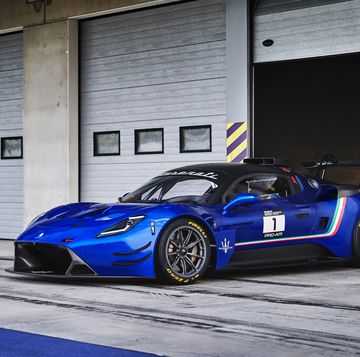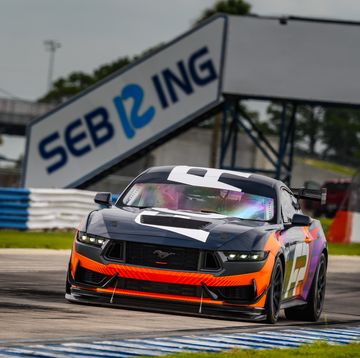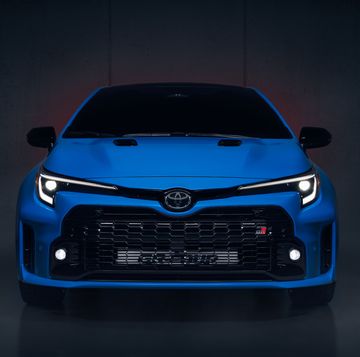- The T.33 is the second supercar from Gordon Murray Automotive after the amazing T.50.
- The T.33 uses a detuned version of the 4.0-liter naturally aspirated V12 from the T.50 but sits on a different core structure to the stablemate, with a central monocoque that uses honeycomb carbon-fiber pieces bonded into an aluminum frame. It offers the choice of a manual or automated gearbox.
- Like with the T.50, only 100 examples will be built, with each asking about $1.85 million.
The T.33 you see here is GMA’s second road-going supercar, following on from the T.50 that was launched in 2020. Compared to its predecessor—although almost nothing else—the T.33 is definitely an understudy, a car designed for a different part of the market. So while the T.50 took obvious inspiration from Murray’s most famous street-legal design, the McLaren F1, with its central driving position, the T.33 has a more conventional two-seat design. The new car has also lost the T.50’s 48V active aerodynamics and has gained weight, although it is still lighter than any rival: Murray says the T.33 is on track to weigh 2400 lbs, versus the T.50’s 2620 lbs. The new car keeps both the V12 powerplant and the option of a manual gearbox, and gains several other new innovations. Just 100 T.33s will be built, for £1.37m (about $1.85 million) each—that’s £1m less than the T.50.
Autoweek got the chance to talk to Murray alongside the T.33 design concept in an underground parking garage at what is going to become GMA’s new HQ in Surrey, England. The first question was meant to be a simple one: Why is the T.33 following the T.50?
“Because when I thought, ‘one day I might do my own car,’ I went through the numbers with Kev Richards, who is now my creative director, and we banked some we liked the sound of,” Murray says. “T.50 was a nice, round number—and we ended up using it to mark 50 years of car design. But the reason we kept T.33 was because I said to Kev that if we’re going to do our own car, it has to have a small capacity engine and I wanted to do a 3.3-liter car. This was five or six years ago.”
When Murray spoke to Cosworth about creating the high-revving naturally aspirated V12 engine GMA would use, the plan encountered a problem: The proposed capacity wouldn’t give enough power. So the engine increased to 4.0-liters, but Murray liked the name so much he decided to keep it.
The V12 is probably the least new component, keeping the same block and heads as the T.50 as well as gear-driven camshafts, but these having less extreme timings, a slightly reduced rev limit, and the torque curve lowered to improve drivability. These things are relative, of course—the T.33’s peak 606 bhp still arrives at a heady 10,500 rpm, and the engine limiter is set at 11,100 rpm, 1000 rpm shy of the T.50’s. Maximum torque is a 332 lb-ft, and although that comes at 9000 rpm, Cosworth say that 75% of that total is available from just 2500 rpm.
“What they’ve achieved blows my mind,” Murray says, “in the ‘60s if an engine went to 12,000 rpm—and none did—then there would have been nothing at all below 8000 rpm.”
GMA will offer the choice of a manual or automated gearbox, both built by British specialist Xtrac. The six-speed manual is the same one fitted to the T.50, and will be come either with or without an overdriven sixth gear for more relaxed cruising. The automated one uses Xtrac’s very clever Instantaneous Gearchange System, which allows the selection of two ratios simultaneously (and then toggled by a ratchet mechanism) to give truly seamless shifting. But although the paddle-shift transmission will be both quicker and lighter—amazingly, it weighs 8.8 lbs less than the full manual—early enthusiasm from potential buyers has been muted.
“I may well have shot myself in the foot,” Murray says, laughing, “because we’ve presold half the cars already, and so far have only had two people order a paddle shift. So I’ve committed myself to millions of pounds in development spend and could end up with 97 manuals and three autos.”
The automated gearbox will definitely be used in future GMA models, which Murray confirms will all need to feature some degree of hybrid assistance.
The T.33 sits on a different core structure to the T.50, with a central monocoque that uses honeycomb carbon-fiber pieces bonded into an aluminum frame. The double-wishbone front suspension is mounted directly to this structure, while the rear is hung from the transmission. Very unusually in this part of the market there are no active dampers, or even a rear antiroll bar. “If you’ve got a very lightweight car with a very low center of gravity and a very low unsprung weight, there’s absolutely no reason why you need to complicate it,” says Murray. Brakes use carbon-ceramic discs, but tires are standard Michelin Pilot 4S Sports in off-the-shelf sizes, Murray not seeing the point of expensive bespoke compounds.
While the T.33 lacks the T.50’s active aerodynamics, it does feature a less aggressive version of the same system. This diverts low pressure air from behind the car when it travels at speed to the underbody diffuser to improve its efficiency, Murray saying that this Passive Boundary Layer control is about 30 percent as effective as the T.50’s 48-Volt fan. There are also diffuser elements at the front hidden in the car’s wheel arches; the T.33’s bodywork being remarkably free of the wings, vents, and ducts common to most supercars.
“Big car companies invariably start with the styling, then do a show car, then if the board and press and public like it, they try to engineer the car,” Murray says. “We don’t even start the styling until we’ve got a package that is finished and that works.”
Murray cites the Lamborghini Miura, De Tomaso Vallelunga, and Porsche 904 as design influences—and there’s definitely something of the Alfa Romeo Tipo 33 Stradale about the rear end, appropriately. But he says the plan was to build a timeless car rather than a retro one, with every surfaced optimized for both aerodynamics and function. Behind the dihedral opening doors there are two side-accessed luggage compartments, these hinging sideways from the rear wheelarch. Together with a frunk under the hood they will give 9.7 cu-ft of luggage space. And although we will have to wait to see the interior—the styling model not having one—Murray promises this will match the uncluttered layout of the T.50, with a large analog rev counter in the center of the dashboard and rotary mechanical controls instead of touchscreen interfaces.
GMA has is also undergoing the considerable costs of putting the T.33 through full Federal-type approval—something that will cost about £28 million ($38 million), according to Murray, and which the company didn’t do for the T.50. That’s why the T.33 gets a much bigger high-level stop light and its headlights incorporate lower ducting, these both supplying cooling air to the front brakes but also satisfying the ‘pole test’ requirement that the lenses not be damaged in a slow impact.
Discussing supercar lighting in general gives the chance to follow Murray down another fascinating rabbit hole: “We benchmarked all the supercar lights properly and found the best throw and spread was the McLaren 720S—it was streets ahead of anybody else. We used a British company called Wipac for the T.50 and T.33, and they’ve managed to make lights that are 15 percent better than the McLaren. Everyone who has experienced them at night says they’re magic.”
Those with the budget and the inclination would be well advised not to delay, the T.50 having sold its full allocation within 48 hours of its official unveiling.
“We have been very careful this time, we had a lot of angry people after the T.50,” says Murray, “some of them saying, ‘I’ve been talking to you for a year and now I can’t have one,’ to which the reply was, ‘Well, we did send you a contract and you didn’t sign it’… What we did this time was go to the T.50 owners and give them a shot at this car, then the people who have been asking repeatedly about the next car. Now we’re going to throw it open to a wider audience.”
Despite the T.33’s lofty price tag it seems certain that GMA could sell more than the 100 it will produce, but Murray insists exclusivity is one of the company’s core principles. “We will do other variants, all at the same rate of 100 a year, but the next one isn’t going to be this with a different rear bumper—it’s going to be a very different car.”
Also, a very different car company. You don’t need to be able to afford one of Gordon Murray’s creations to be very glad that both they, and he, exist.
Share your thoughts on the Gordon Murarry T.33—or just on the man and his genius—in the comments below.
Our man on the other side of the pond, Mike Duff lives in Britain but reports from across Europe, sometimes beyond. He has previously held staff roles on U.K. titles including CAR, Autocar, and evo, but his own automotive tastes tend toward the Germanic: he owns both a troublesome 987-generation Porsche Cayman S and a Mercedes 190E 2.5-16.

